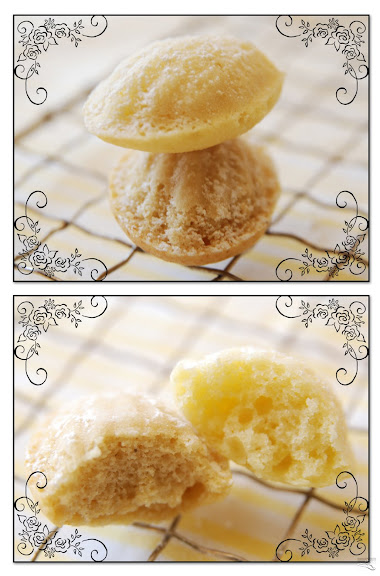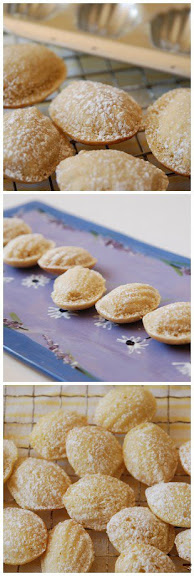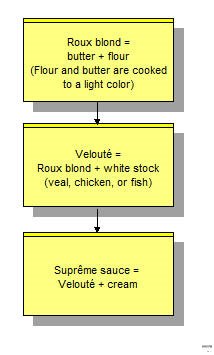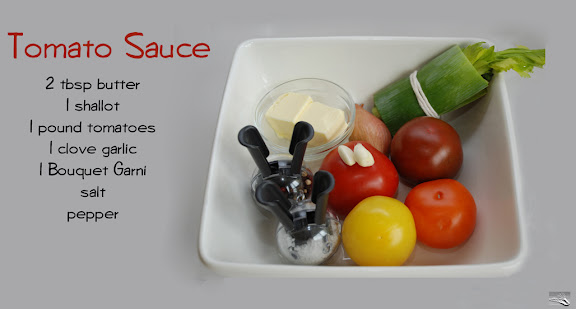.jpg) I decided to join the Daring Bakers, started by Lis of La Mia Cucina and Ivonne of Cream Puffs in Venice, who in November 2006 decided to try baking the same recipe and writing about it. Gradually, it grew into a sizeable baking group that currently has more than 700 members dedicated to baking something daring each month. This month was truly daring‑Opéra Cake. A multi-layered cake of delicious cake, syrup, mousse, and ganache that requires perfection and patience (both of which I need to work on!). Its undecorated sides show all the layers and all the imperfections that I usually rely on icing to hide!
I decided to join the Daring Bakers, started by Lis of La Mia Cucina and Ivonne of Cream Puffs in Venice, who in November 2006 decided to try baking the same recipe and writing about it. Gradually, it grew into a sizeable baking group that currently has more than 700 members dedicated to baking something daring each month. This month was truly daring‑Opéra Cake. A multi-layered cake of delicious cake, syrup, mousse, and ganache that requires perfection and patience (both of which I need to work on!). Its undecorated sides show all the layers and all the imperfections that I usually rely on icing to hide!History (and a dedication)
According to Food Timeline, Opéra Cake is a modern, 20th-century cake with ancient roots. A typical Opéra Cake consists of an almond sponge cake with a coffee and chocolate filling and icing. In this version, the Daring Bakers put a “light” (color not calories) twist on it for Spring.
Recipe: Opéra Cake
This is a long recipe with 5 parts, but each component is not hard. And, the good thing is you can do 4 of the 5 parts ahead of time.To see the different Opéra Cakes cropping up all over the food blog world, check out the Daring Bakers Blogroll.
This recipe is based on Opéra Cake recipes in Dorie Greenspan’s Paris Sweets (affiliate link) and Tish Boyle and Timothy Moriarty’s Chocolate Passion (affiliate link).
.jpg)
Joconde
The cake part of Opéra Cake is made up of a sponge cake called a joconde, named for the Mona Lisa (La Joconde in French). Some spell joconde as “jaconde”, but joconde is the proper way to spell it. The married name of Lisa Gherardini, who is believed to be the subject of da Vinci's portrait, is Giocondo, which means cheerful and full of good humor in Italian, as does “jocund” in English. Perhaps it's the lightness of the sponge cake that gives joconde its name.
Divide the oven into thirds by positioning a rack in the upper third of the oven and the lower third of the oven.
Preheat the oven to 425˚F (220˚C).
Line two 12½ x 15½- inch (31 x 39-cm) jelly-roll pans with parchment paper and brush with melted butter.
In the bowl of a stand mixer fitted with the whisk attachment (or using a handheld mixer), beat the egg whites until they form soft peaks. Add the granulated sugar and beat until the peaks are stiff and glossy. If you do not have another mixer bowl, gently scrape the meringue into another bowl and set aside.
In another bowl of a stand mixer fitted with the paddle attachment (or using a handheld mixer), beat the almond flour (or chestnut flour), icing sugar, and eggs on medium speed until light and voluminous, about 3 minutes.
To make almond flour, you mix 50% ground almonds with 50% icing sugar. This is called "Tant pour Tant" ("that much for that much"). You can do this with chestnuts too, but I was able to find both almond and chestnut flour at a specialty grocery store. I tried joconde twice: once with almond flour and once with chestnut flour. Although both sponge cakes were delicious, the almond played a better supporting role for the other layers.
.jpg) Add the all-purpose flour and beat on low speed until the flour is just combined (be very careful not to overmix here!).
Add the all-purpose flour and beat on low speed until the flour is just combined (be very careful not to overmix here!).Using a rubber spatula, gently fold the meringue into the almond mixture and then fold in the melted butter. Divide the batter between the pans and spread it evenly to cover the entire surface of each pan. A tip I read was to run your thumb against all sides of the pan to prevent over-baking at the edges.
Place one jelly-roll pan in the middle of the oven and the second jelly-roll pan in the bottom third of the oven. Bake the cake layers until they are lightly browned and just springy to the touch. This could take anywhere from 5 to 9 minutes depending on your oven. Do not over-bake. It should only take a little color.
Put the pans on a heatproof counter and run a sharp knife along the edges of the cake to loosen it from the pan. Cover each with a sheet of parchment or wax paper, turn the pans over, and unmold.
Carefully peel away the parchment, then turn the parchment over and use it to cover the cakes. Let the cakes cool to room temperature.
Note: The joconde can be made up to 1 day in advance and kept wrapped at room temperature.
Syrup
Stir all the syrup ingredients together in the saucepan and bring to a boil. Remove from the heat and let cool to room temperature.
Note: The syrup can be made up to 1 week in advance and kept covered in the refrigerator.
Buttercream
Combine the sugar, water and vanilla bean seeds or extract in a small saucepan and warm over medium heat just until the sugar dissolves.
Continue to cook, without stirring, until the syrup reaches 225˚F (107˚C) on a candy or instant-read thermometer. Once it reaches that temperature, remove the syrup from the heat.
According to Joe Pastry, the baking guru I like to consult, “eggs must be warm before you begin. Why? The answer is that a cake batter is an emulsion, which is to say, a matrix of tiny fat blobs dispersed in a watery medium. That emulsion plays a critical role in leavening the cake, and in maintaining its soft, creamy texture.” So, warm those eggs before starting this buttercream.
While the syrup is heating, begin whisking the egg and egg yolk at high speed in the bowl of your mixer using the whisk attachment. Whisk them until they are pale and foamy.
When the sugar syrup reaches the correct temperature and you remove it from the heat, reduce the mixer speed to low speed and begin slowly (very slowly) pouring the syrup down the side of the bowl being very careful not to splatter the syrup into the path of the whisk attachment. Some of the syrup will spin onto the sides of the bowl but don’t worry about this and don’t try to stir it into the mixture as it will harden!
Raise the speed to medium-high and continue beating until the eggs are thick and satiny and the mixture is cool to the touch (about 5 minutes or so).
While the egg mixture is beating, place the softened butter in a bowl and mash it with a spatula until you have a soft creamy mass.
With the mixer on medium speed, begin adding in two-tablespoon chunks. When all the butter has been incorporated, raise the mixer speed to high and beat until the buttercream is thick and shiny.
At this point add in your flavoring and beat for an additional minute or so.
Refrigerate the buttercream, stirring it often, until it’s set enough (firm enough) to spread when topped with a layer of cake (about 20 minutes).
Note: The buttercream can be made up to 1 month in advance and packed in an airtight container. If made way in advance, you can freeze the buttercream. Alternatively you can refrigerate it for up to 4 days after making it. To use the buttercream, simply bring it to room temperature and then beat it briefly to restore its consistency, if needed.
Mousse
Melt the white chocolate and the 3 tablespoons of heavy cream in a small saucepan. Stir to ensure that it’s smooth and that the chocolate is melted. Add the tablespoon of liqueur to the chocolate and stir. Set aside to cool completely.
In the bowl of a stand mixer, whip the remaining 1 cup of heavy cream until soft peaks form. Gently fold the whipped cream into the cooled chocolate to form a mousse.
If it’s too thin, refrigerate it for a bit until it’s spreadable. If you’re not going to use it right away, refrigerate until you’re ready to use.
Note: The mousse can be made ahead and refrigerated until you’re ready to use it.
Glaze (ganache)
Note: Make the glaze when you’re ready to finish the cake.
Melt the white chocolate with the heavy cream. Whisk the mixture gently until smooth. Let cool for 10 minutes and then spread over the chilled cake. Using a long metal cake spatula, smooth out into an even layer.
Place the cake into the refrigerator for 30 minutes to set.
Assembling
Note: The finished cake should be served slightly chilled. It can be kept in the refrigerator for up to 1 day (but I stored it for more than a week, and we still enjoyed every crumb!).
Line a baking sheet with parchment or wax paper.
Working with one sheet of cake at a time, cut and trim each sheet so that you have two pieces (from each cake so you’ll have four pieces in total): one 10-inch (25-cm) square and one 10 x 5-inch (25 x 12½-cm) rectangle.
Place one square of cake on the baking sheet and moisten it gently with the flavored syrup.
Spread about three-quarters of the buttercream over this layer.
Top with the two rectangular pieces of cake, placing them side by side to form a square. Moisten these pieces with the flavored syrup.
Spread the remaining buttercream on the cake and then top with the third square of joconde. Use the remaining syrup to wet the joconde and then refrigerate until very firm (at least half an hour).
Prepare the mousse (if you haven’t already) and then spread it on the top of the last layer of the joconde. Refrigerate for at least two to three hours to give the mousse the opportunity to firm up.
Make the glaze and after it has cooled, spread it over the top of the chilled cake. Refrigerate the cake again to set the glaze.
Serve the cake slightly chilled.
Makes approximately 20 servings.
.jpg) Tasting Notes
Tasting NotesWe enjoyed both the almond and chestnut Opéra Cakes, but preferred the almond one just slightly. One of my daughters even wanted this for her birthday cake! Each part was delicious: the syrup, the sponge cake, the buttercream, the mousse, and the ganache. So together, how could it go wrong? I kept stealing tastes as I was assembling it. I think one of the tricks to making a perfect layer cake is to put a ton of buttercream in-between each layer, which might level it out better. I’m going to have to make this over and over again to improve my layering skills, but I don’t think anyone will mind!
Someday, maybe mine will look more like these:
• A perfect Opéra Cake from Bonbini
• Dalloyau's (pronounced doll-why-oh) in Paris, considered by pastry chefs in the know to be the best according to Paris Breakfasts
• Green Tea Opéra Cake from Nordljus
I’m looking forward to seeing the variety of Opéra Cakes from the Daring Bakers this month!
More to Explore:












.jpg)





.jpg)

.jpg)
.jpg)

.jpg)

.jpg)
.jpg)
+1024.jpg) Weekends are a time to kick back, sit on the deck, and sip some lemonade or limeade with friends and family.
Weekends are a time to kick back, sit on the deck, and sip some lemonade or limeade with friends and family.

.jpg)
.jpg)
.jpg)
.jpg)









.jpg)
.jpg)
.jpg)
.jpg)

.jpg)
.jpg)